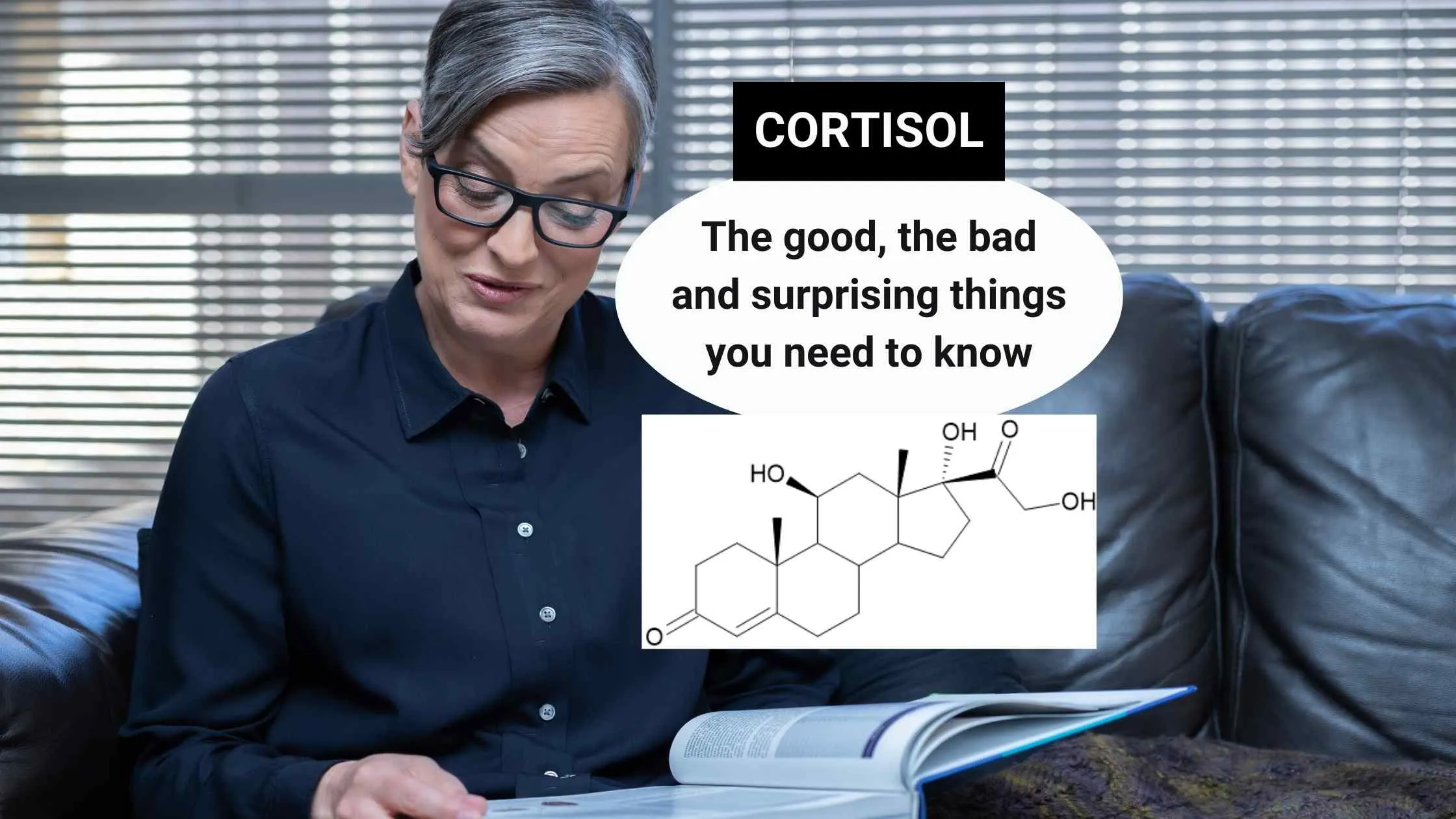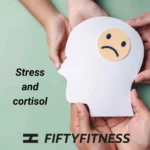Cortisol – the good, the bad and surprising things you need to know

Cortisol molecular structure
I’m always interested in knowing the molecular structure of substances. Yes, I know, I’m a nerd.
As a chemist though, I know that the molecular structure of anything makes it do what it does and that’s why I’m always curious.
Cortisol is a steroid. I can tell this by looking at a representation of its molecular structure.

It’s the system of rings fused in that order that makes it a steroid.
Other steroids you may have heard of include oestrogen and testosterone.
Even if you don’t fully understand what the molecular structure representations mean, can you see how they belong to the same class of compounds?
Naturally occurring hormone
Hormones are substances that regulate biological processes at the cellular level.
We have a bunch of them, and cortisol is but one.
It’s produced by the adrenal glands and plays an important role in regulating our bodily response to stress, as well as many other physiological functions.
Cortisol plays a number of roles in the body
1. Regulation of blood sugar levels
2. Suppressing the immune system
3. Regulating blood pressure
4. Plays a role in metabolism
5. Sleep/wake cycle regulation
Our cortisol levels vary during the day
There are natural variations in our cortisol levels throughout the day, peaking in the morning and at their lowest overnight.
The peak in the morning prepares us for the day ahead.
Over the course of the day, cortisol levels decrease gradually to a trough while we’re sleeping.

Adverse effects of increased levels
While cortisol is necessary and plays a vital role in our response to stress – it’s part of the classic ‘fight or flight’ response – prolonged elevation of our cortisol levels can have adverse effects on the body.
1. Increased blood sugar levels – increasing the risk of developing type 2 diabetes
2. Suppressed immune function – increasing the risk of infections
3. Elevated blood pressure – increasing the risk of cardiovascular and other diseases
4. Chronically elevated cortisol levels have been linked to an increased risk of anxiety and depression

Stress and cortisol
Prolonged elevation of our cortisol levels is often due to chronic stress.
We all know that stress is not good for our health overall and the impact of cortisol is a big factor.
Learning the adverse effects of elevated cortisol is a real wakeup call for me to find ways to manage my stress.
I’m great at maintaining my daily exercise habits, but not so strong on regular stress busting practices.

Exercise and cortisol
Exercise can affect cortisol levels in various ways, depending on the type, intensity, and duration of the exercise.
In general, high intensity or prolonged exercise tends to increase cortisol levels.
This is because exercise puts stress on the body, which includes the release of cortisol from the adrenal glands.
However, regular exercise can also have a beneficial effect on cortisol levels over time.
Studies have shown that people who engage in regular physical activity tend to have lower cortisol levels overall, as well as a more adaptive response to stress.
Exercise time of day and recovery
There is a school of thought that suggests the morning is a better time of day to exercise because it works with the natural variation of cortisol throughout the day.
But everyone needs to consider their preference and schedules when choosing their time to exercise.
Cortisol levels remain high post exercise before returning to normal.
We may be able to help this process along with recovery strategies like massage or relaxation.
The most important thing for managing cortisol levels overall, and avoid overtraining generally, is to allow enough recovery time between workouts.

Cortisol and abdominal fat
You may have heard of a correlation between elevated cortisol levels and accumulation of fat in the abdominal area, and there is research to back this up.
This suggests that managing stress, and therefore cortisol levels, may decrease our risks for metabolic disorders like type 2 diabetes which are associated with carrying abdominal fat.
My body tends to accumulate belly fat no matter what I weigh on the scales.
Another reason for me to look at my stress management, or lack thereof!

Cortisol and menopause
The main hormonal change we associate with the transition to menopause is declining oestrogen levels, but cortisol is another one to consider.
I only learned recently that our cortisol levels increase during this time.
This is an important hormonal change to be aware of for all the reasons outlined above.
And it’s a more important time than ever to be prioritising stress management, exercise, recovery, sleep, nutrition and how we manage our menopause symptoms generally.
All these things contribute to regulating cortisol levels.
Cortisol as a drug
The pharmaceutical drug hydrocortisone has the exact same molecular structure as cortisol.
Rather than being harvested from an adrenal gland, the pharmaceutical variety is synthetised in a lab.
The synthesis of naturally occurring compounds from commercially available chemicals in this way was one of the things I used to do as a chemist.
Chemists can prepare and purify compounds that are identical to naturally occurring ones, in much larger quantities.
Why take cortisol as a drug?
Hydrocortisone is mainly used as a treatment for allergies and conditions that cause inflammation, such as asthma and arthritis, but there are a wide range of applications.
I’ve used hydrocortisone in ointments for skin irritations and haemorrhoids! It’s a marvellous drug.
However, every hydrocortisone cream I’ve ever used comes with a warning to use it for a short time only – a few days or up to a week.
I’m sure you can imagine, having read about the adverse effects of elevated cortisol levels in the body, why short-term steroid treatment is advised.
That’s right, there are many adverse effects from prolonged use of steroid drugs, and this should only be done under close medical supervision.
In summary
Cortisol is a naturally occurring steroid hormone that helps our body respond to acute stress – fight or flight.
However, prolonged elevation of cortisol, most commonly due to stress, has adverse physiological effects and is linked to accumulation of abdominal fat.
Cortisol levels vary during the day, in response to exercise and during the transition to menopause.
The pharmaceutical drug hydrocortisone has the same molecular structure as cortisol. It’s a useful drug but must be used with caution.
This precaution reinforces that we need to be mindful of how we can manage our natural cortisol levels through stress management, exercise, sleep and recovery, and overall healthy living.
Free resources at fiftyfitness.com.au
Did you know that I have a bunch of FREE resources on my website?
I’ve developed them to help over 50s get started or return to exercise.
You’ll find a workbook with 10 things to consider when you’re considering exercise.
There’s a home workout that requires no equipment.
And TWO video series. One to help you develop a daily warm up routine. The other provides tips on how to care for your pelvic floor while you workout.
So much goodness available for FREE!

Keep in touch
Please reach out to me if anything in this article resonates with you.
You can email me at kate@fiftyfitness.com.au or connect via social media.

Subscribe now
Blog Subscription Form
A blog subscription form, used for the blog page and posts.
"*" indicates required fields